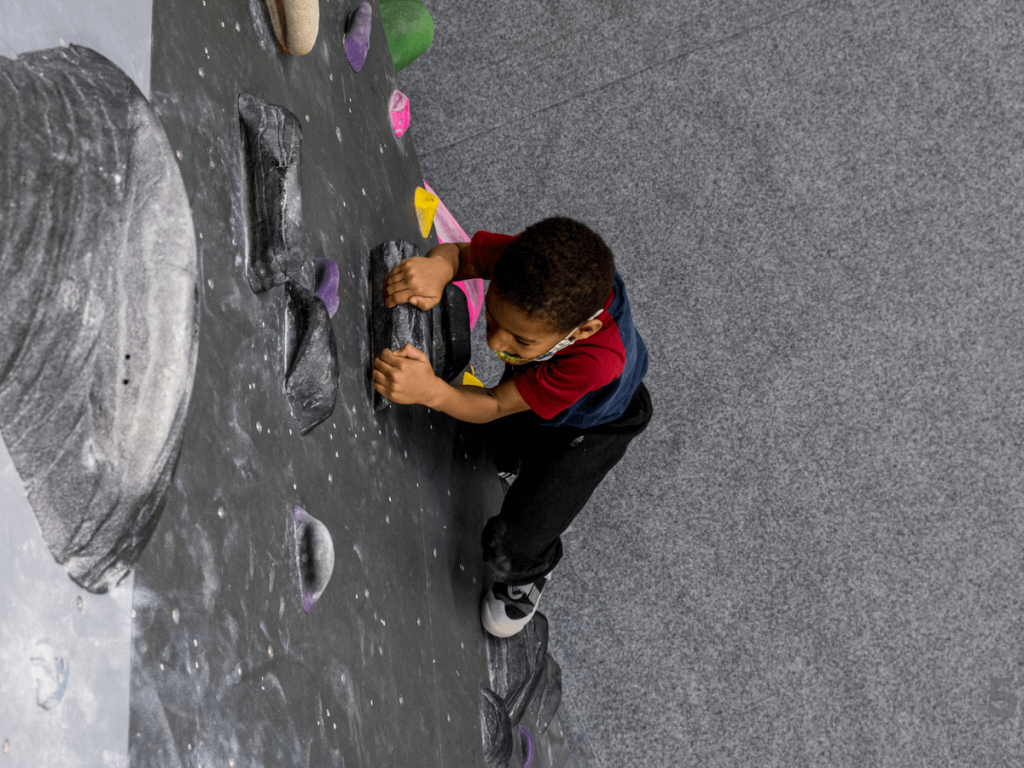The best indoor rock climbing camp is the one that your child talks about for the rest of the year. Has your child expressed how fun it would be if they could spend a whole day rock climbing? Or have you expressed how great it would be if they spent a whole day rock climbing? Think of all the errands you could run, like grocery shopping or picking up dry cleaning! Or better yet, the relaxation you could have, like reading a book or getting a massage.
Every parent gets it: They love their kids, but sometimes, they just want a break! That’s where indoor rock climbing camps come in. They’re not just a fun way for your child to spend their day but also an excellent opportunity for them to learn something new, develop their physical skills, and build confidence. So, while your child is having a blast at the camp, you can enjoy your day however you want!
Check out these expert tips for parents when choosing the BEST indoor rock climbing camp for your child.

Half-day or Full-day?
When considering a camp at an indoor climbing gym, consider how much free time you want during the day. Sorry, consider how long your child wants to spend at the gym!
Most camps offer half-day and full-day options and can be booked for a single day, a week, and more!
A half-day is perfect if you want your child to glimpse what a whole day can offer. Plus, it’s ideal if you just need a little time in the morning to run some errands child-free. Imagine the convenience of having a few hours to yourself while your child is having a great time at the camp. It’s a win-win situation for both you and your child!
Instructor-to-Student Ratio
When contacting your local climbing gym about their camp, ask about their instructor-to-student ratio. This is the number of instructors per child and will let you know how much one-on-one your child will get (if needed) and how many other kids will typically be at the camp. For example, a 1:5 ratio means there is one instructor for every five children, ensuring that each child receives adequate attention and guidance.
Many camps have an age range where they group the climbers. This way, your twelve-year-old won’t need to hang around a 5-year-old if they don’t want and your small child won’t feel overwhelmed trying to keep up with the big kids.
Ask About Other Activities!
As you can imagine, climbing all day is hard. It takes a lot of energy and strength; not even the most elite climbers can spend an entire day climbing. Ask about the extra camp activities and see how they break up the climbing.
Typically, camps will offer learning activities like small science projects and play different games to give the children a rest. During lunchtime, they may even provide a climbing video option to expose your child to where rock climbing can take them! Ask whether the gym offers snacks and lunch or if your child needs to bring their own.
Here are a few questions you may have when considering enrolling your child in a rock climbing camp:
Are rock climbing camps safe?
Rock climbing is never safe. Rock climbing camp gyms are designed with risk mitigation as the top priority. Ample foam padding surrounds the facility, cushioning any falls. Your child will learn to fall correctly and practice it with their instructors until they feel comfortable climbing. Instructors are there to help your child climb and minimize any risk. So, you can rest assured that your child is in good hands at the camp.
Of course, a fall is the last case scenario when climbing. The idea is to get to the top! After this, they downclimb using the large holds on the wall. Downclimbing is a technique where climbers descend the wall by moving their hands and feet in a controlled manner, using the large holds on the wall as support.
However, rock climbing is inherently dangerous. The instructors are there to minimize any risk. Please make sure your children will follow directions and listen to instructors during their time at camp.
What should my child wear?
Your child should wear clothing that isn’t restrictive and allows them to move their body freely. This could include loose-fitting pants or shorts and a comfortable, breathable shirt. Climbing requires a ton of movement and is performed best when clothing doesn’t get in the way.
It’s recommended that they wear a T-shirt and lightweight pants to prevent them from bumping their knees into the wall.
Does my child need climbing gear?
Your children should be fine without their own gear to attend a climbing camp. If they already have some, great! They can bring their own gear. Instructors will provide your child with climbing shoes, a harness, and a helmet if they don’t have any.
What should my child bring?
Your child should bring a pack filled with a water bottle, sandals/flip flops, and snacks/lunch if it is not provided at camp. The pack is important because it allows your child to carry their belongings while climbing. Climbing can be challenging, so having a handy water bottle is a great choice. Sandals are essential because gyms don’t allow climbing shoes in the restrooms, and switching to their laced shoes each time can be a hassle.
Sandals are essential because gyms don’t allow climbing shoes in the restrooms, and switching to their laced shoes each time can be a hassle.
Of course, snacks and lunch are incredibly important if your child spends a full day at the gym!

Recent Comments